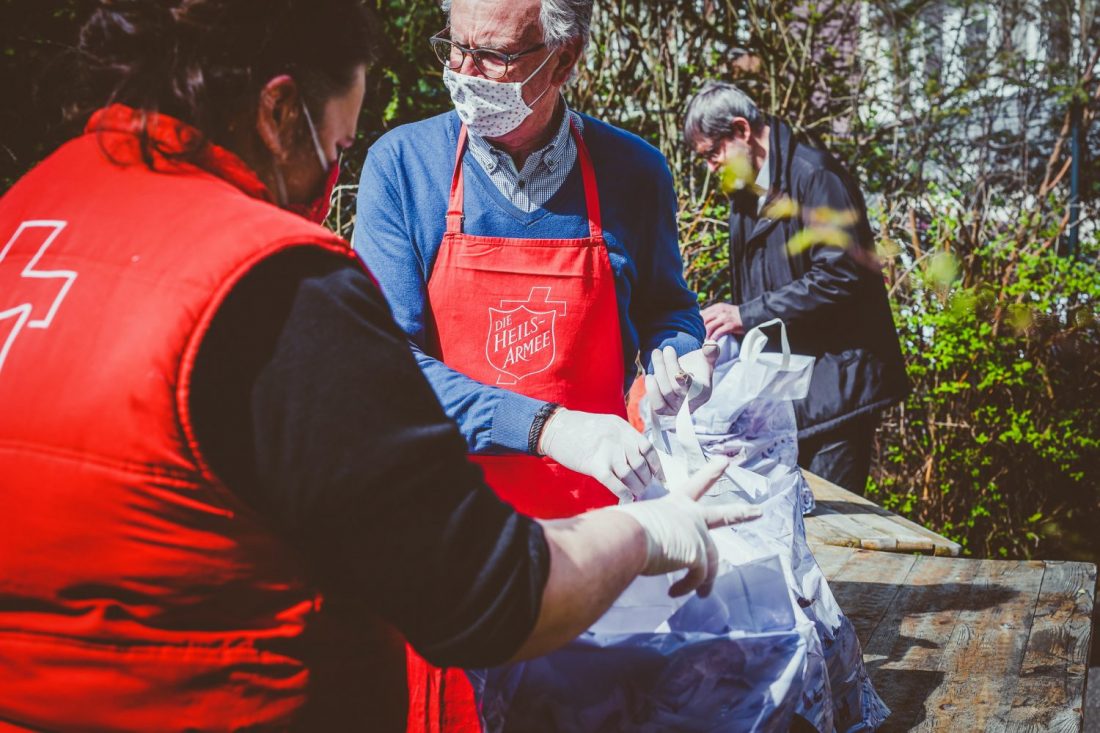 Bonnet Blocks–(top) were were used to make the early, deep brimmed bonnets (below).
Bonnet Blocks–(top) were were used to make the early, deep brimmed bonnets (below).
by Frances Dingman
The bonnet! The “helmet of salvation!” Though seldom seen in the world of today, it remains in the minds of the public a symbol of The Salvation Army and its work for mankind.
Mrs. Catherine Booth, the “Army Mother,” took a special interest in the question of uniform. Careful to dress with neat modesty, and often taken for a Quaker lady, she sometimes was not pleased with the fashions of the day.
Even within the Mission, some of the members had dressed in some way resembling the fashions of the world. Others, trying to avoid this and having no taste of their own, had adopted unsuitable costumes. Some of the Mission ladies wore a small “Mission bonnet,” hardly more than a circle with a ruffle around it, and a ribbon under the chin. Mary Stillwell said, “…I put aside my old Mission bonnet and became a Salvation Army officer.”
By 1880, Mrs. Booth set to make Salvation Army headgear which would be at once plain, distinctive, and attractive. Shutting herself up in a room with her daughter Emma, and surrounded by a heap of bonnets of various sorts and sizes, she tried to come up with something that would be suitable to all. The “Hallelujah bonnet” was at last hit upon, and it was named the “helmet of salvation” for the women warriors of The Salvation Army. At first it was secured by wide ribbon in a bow which came directly under the chin.
Changes with the times
It was not intended that it should be unalterable, as with monks and nuns. At any time, if it should not be in harmony with popular dress, there was full liberty to make such alterations as would keep the Army in touch with the masses. The object was always to combine simplicity with the testimony of separation from the world. It was not meant to be used without considering national customs. In the East the bonnet was readily discarded for the graceful Oriental veil, but with a special color to distinguish it.
In public it was meant to be a perpetual reminder to the careless and ungodly, forcing them to think of the “eternity to which they are hurrying.”
In an article in the Pacific Coast War Cry, Mrs. Captain McIndoe writes in 1893 of the “old days.” “You wouldn’t just go out and buy a bonnet,” she recalled. “You would take an old bonnet to have it blocked (there were only two or three hat blocks on the West Coast.) I wore the first blue bonnet in the West. Dresses were plain, dark blue wrappers with long sleeves.”
In time, the roughness which greeted the women at open air meetings made a deeper bonnet advisable to protect their heads. Around the 1890s the “coal scuttle bonnet” was worn. It became a familiar trademark of the beloved Commander Evangeline Booth
A modification of this style resulted in a bonnet with an abbreviated brim which nicely framed the face, in “English” or with slight variation the “American” style. The wide ribbon was tied to the left side, with long ends hanging down in front.
Alternative hats emerge
In any given era, considering the wide range of climate in which the uniform was worn, there would be a contemporary style hat as an alternative. In 1904, the Trade Department advertised the “summer hat,” echoing the popular style of “sailor” hat with a wide brim. This is often seen on older women up until the ’30s.
When the flappers of the 1920s adopted the cloche hat, the S.A. alternative hat followed suit, with a deep crown coming down over the forehead. In a modified version, skirts came up to below the knee while cloth belts sank below the waist on a one-piece dress, then dipping in the early ’30s and rising again during the war to the current style.
An alternative slouch hat emerged during depression years, echoing those worn by well-known ladies such as Greta Garbo and Carole Lombard.
As more women joined the armed services, their jaunty military-style hat influenced the Salvation Army hat to be worn for work use or when the bonnet was neither suitable nor comfortable. Sometimes, as for USO work, a small “overseas hat” served well.
The bonnet itself became smaller and smaller, with a bow permanently attached to the left side and a chin strap with a snap closing. Missionary officers, often serving in heat and humidity, favored a cool white hat of straw or felt, with a small brim, to go with their tropical uniforms.
Appearing in the ’50s, a one-piece uniform dress was worn with zipper down to reveal a red dickey with an elegant embroidered crest. Use of this dress varied in different territories. After the demise of this style, men’s and women’s uniform tunics for the first time became almost identical, with a stiffened, stand-up collar.
The bonnet, which for many remains a treasured symbol of The Salvation Army, has almost disappeared in the United States since 1978. The lapel uniform, however, became regulation in 1980. As late as a 1985 brochure, stand-up collars and bonnets were still considered acceptable. In February 1994 Commissioners’ Conference minutes, references to bonnets and stand-up collar accessories were removed from the Uniform Assistance Plan. Many bewail the passing of the bonnet, still seen in Britain and elsewhere.
There is no regulation tie for women, but brooches are permitted. The “fatigue” uniform, far from the G.I.’s camouflage coveralls, consists of white overblouse with epaulets denoting rank, and regular navy skirt.
The hat varies from territory to territory, largely depending on which style is preferred by its administration. Its style is always in keeping with the tailored tunic and skirt. The present Western hat design originated in the Canadian Territory.












